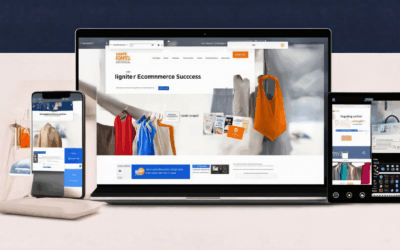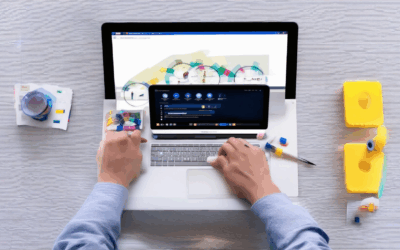Designing a seamless and engaging website user journey is crucial for any online platform aiming to captivate and convert visitors. Whether you’re building a new site or optimizing an existing one, understanding the intricacies of user experience (UX) design is key to keeping users engaged and guiding them toward desired actions. This guide delves into the essential elements that make up a user journey, focusing on the 5 E’s—Entering, Engaging, Exploring, Experiencing, and Exiting—to craft a CJM (Customer Journey Map) that aligns with both user needs and business objectives. By mastering these principles, you’ll unlock the power to create a website that not only stands out but also resonates deeply with its audience, driving success through a well-planned and executed user journey.
Key Takeaways
- Understand the 5 key stages of the customer journey: From awareness to post-purchase, each stage plays a vital role in shaping the user experience.
- Identify and map all touchpoints: List every interaction, including websites, social media, and emails, to design a seamless experience.
- Visually represent the journey with tools: Use sticky notes or digital software to sketch and organize the customer path.
- Analyze gaps in the customer experience: Look for areas needing improvement to enhance satisfaction and engagement.
- Involve multiple stakeholders in the process: Collaborate with sales, marketing, and customer support for a holistic view.
- Regularly review and iterate based on feedback: Update your CJM continuously to reflect evolving customer needs.
- Use CJM to address specific customer pain points: Solve real problems, like enhancing sustainability info in product descriptions.
- Follow a systematic approach to create CJMs: Define goals, conduct research, prototype, test, develop, and iterate for success.

How to Create a User Journey for a Website
To craft an effective user journey for your website, follow these organized steps:
- Define Your Target Audience : Begin by clearly identifying who your primary users are. Conduct research through surveys or analytics tools to understand their behaviors, preferences, and pain points.
- Analyze Entry Points : Examine how users arrive at your site, whether via organic search, referrals, or social media. Optimize landing pages to align with user intent, ensuring a seamless first impression.
- Design Intuitive Navigation : Create a logical menu structure that mirrors user mental models. Use clear categories and place popular sections prominently. Utilize internal links strategically to guide users effortlessly through your site.
- Map User Flows : Outline the sequence of actions users take, focusing on conversion points. Simplify processes to reduce friction and boost completion rates for key actions like sign-ups or purchases.
- Deliver Compelling Content : Develop high-quality, relevant content that resonates with your audience. Present information in engaging formats such as articles, videos, or infographics to maintain interest and encourage exploration.
- Optimize Exit Points : Analyze why users leave your site. Improve areas causing dissatisfaction, such as confusing checkout processes or underperforming content. Test different exit points to identify improvement opportunities.
- Test and Iterate : Implement A/B testing to refine elements like CTAs or layout. Continuously monitor user behavior and gather feedback to make data-driven enhancements.
- Personalize the Experience : Tailor content and recommendations based on user segments to boost engagement. Ensure personalization feels natural and avoids overwhelming users.
By systematically addressing each aspect, you can create a cohesive and engaging user journey that enhances visitor experience and drives desired outcomes.
User Journey in UX Design
A user journey in UX design refers to the sequence of interactions a user has with a product, system, or service, from their very first encounter until they achieve their goal. It encompasses every touchpoint, experience, and interaction along the way, providing a holistic view of how users engage with a product. Understanding the user journey is crucial for designing intuitive and satisfying experiences that meet user needs and drive desired outcomes.
Key Components of a User Journey:
- Touchpoints : These are the various interfaces or platforms where a user interacts with a product or service. Examples include websites, mobile apps, physical devices, or in-person interactions.
- Pain Points : Identifying where users struggle or face challenges is essential. These could be confusing navigation, slow loading times, or unclear communication.
- Emotional Experience : Beyond functional aspects, the user journey involves emotional engagement. Positive experiences foster loyalty, while negative ones can lead to dissatisfaction and churn.
- Goal Achievement : The journey culminates in the user achieving their intended purpose, whether it’s purchasing a product, completing a task, or simply finding information.
Why User Journeys Matter:
- User Satisfaction : By mapping out the user journey, designers can streamline processes and reduce friction, leading to happier users.
- Retention and Conversion : A well-designed journey can increase customer retention and boost conversion rates by aligning actions with user intentions.
- Innovation : Analyzing user journeys reveals opportunities for improvement and innovation, ensuring products remain relevant and competitive.
Tools for Creating User Journeys:
- Journey Mapping Software : Tools like Figma, Sketch, or Adobe XD provide visual frameworks for mapping out user journeys.
- Surveys and Interviews : Gathering feedback through surveys or interviews helps identify pain points and preferences.
- Analytics : Tracking user behavior on digital platforms reveals patterns and areas for optimization.
By focusing on the user journey, designers can create experiences that are not only functional but also emotionally resonant, driving success for both users and businesses.

The 5 E’s of the Customer Journey
The customer journey is a critical concept in understanding how customers interact with a brand. It involves mapping out the various stages a customer goes through before, during, and after purchasing a product or service. One popular framework used to describe these stages is the “5 E’s” of the customer journey. These stages help businesses understand where they can improve their processes, products, and services to enhance the overall experience.
1. Entice
The first stage of the customer journey is enticing . At this point, potential customers are aware of your brand or product but have not taken any concrete actions yet. The goal here is to capture their attention and interest. This can be achieved through effective marketing campaigns, social media engagement, or compelling content that highlights the unique benefits of your offering.
- Examples:
- A catchy ad campaign highlighting the features of your product.
- A free trial or demo offered to pique curiosity.
- Influencer partnerships or testimonials from satisfied customers.
2. Enter
Once a customer has been enticed, they move into the enter phase. This is where they actively engage with your brand, possibly visiting your website, signing up for newsletters, or exploring your products/services further. The challenge here is to convert this initial interest into something more tangible.
- Best Practices:
- Ensure your website and landing pages are user-friendly and provide clear value propositions.
- Offer incentives for sign-ups, such as discounts or exclusive content.
- Streamline the registration or purchase process to reduce friction.
3. Engage
The engage phase is where customers begin to interact deeply with your brand. They may purchase your product, use your service, or participate in your community. The key here is to foster a positive and memorable interaction that builds loyalty.
- Strategies:
- Provide personalized recommendations based on customer preferences.
- Create forums or communities where customers can share experiences and get support.
- Offer ongoing support and assistance to ensure customers feel valued.
4. Exit
After engagement comes the exit phase. Here, customers have completed their primary goal, whether that’s making a purchase, using a service, or achieving a specific outcome. The focus now shifts to encouraging repeat interactions and gathering feedback.
- Actions:
- Send follow-up emails or messages to thank customers for their interaction.
- Collect feedback through surveys or reviews to identify areas for improvement.
- Provide options for upselling or cross-selling based on customer behavior.
5. Extend
The final stage of the customer journey is extend , where loyal customers continue to interact with your brand beyond their initial transaction. These are the customers who are most valuable to your business as they are more likely to make repeat purchases and recommend your brand to others.
- Retention Strategies:
- Develop loyalty programs or rewards systems to encourage repeat business.
- Maintain consistent communication to keep your brand top-of-mind.
- Build long-term relationships through ongoing engagement and support.
By understanding and optimizing each of these stages, businesses can create a more seamless and satisfying customer experience, ultimately leading to higher satisfaction, retention, and advocacy among their customers.
HubSpot and Forrester provide valuable insights into optimizing the customer journey.

How to Build a Customer Journey Map
A Customer Journey Map (CJM) is a visual representation of the stages a customer goes through when interacting with your brand. Below is a step-by-step guide to building an effective CJM:
- Define the Stages of the Customer Journey
- Awareness : How potential customers discover your brand.
- Consideration : What factors influence their decision-making process.
- Decision : The final choice to engage with your brand.
- Post-Purchase : Ensuring satisfaction and loyalty after the transaction.
- Identify Touchpoints
- List every interaction between your brand and the customer.
- Examples include website visits, social media ads, email campaigns, sales calls, and customer support interactions.
- Map the Journey Visually
- Use tools like sticky notes or digital software to sketch out each stage and touchpoint.
- Create a timeline or flowchart to illustrate the customer’s path from awareness to post-purchase.
- Analyze Gaps
- Identify where the customer journey may lack engagement or information.
- Look for pain points that could hinder the customer experience.
- Involve Stakeholders
- Collaborate with teams like sales, marketing, and customer support to gather diverse insights.
- Conduct surveys or interviews with existing customers to understand their experiences.
- Review and Iterate
- Regularly update the CJM based on feedback and data.
- Test the map with real customers to ensure it reflects their actual journey.
By following these steps, you can create a CJM that aligns with your brand’s goals and enhances the overall customer experience.
What Does CJM Look Like?
A Customer Journey Map (CJM) is a visual tool used to depict the various stages and touchpoints a customer encounters when interacting with a brand. It provides a comprehensive overview of the customer experience journey, from initial awareness to post-purchase engagement.
Key Components of a CJM:
- Awareness Stage :
- How potential customers discover your brand or product.
- Channels involved, such as social media, online ads, or word-of-mouth.
- Consideration Stage :
- What factors influence a customer’s decision to choose your product or service.
- Includes comparison with competitors and evaluation of features vs. alternatives.
- Decision Stage :
- Final steps before making a purchase, including purchasing decisions and payment processes.
- Factors influencing the final choice, such as reviews, pricing, or promotions.
- Onboarding Stage :
- Experience after the purchase, including delivery, setup, or activation.
- Initial interactions with the product or service post-purchase.
- Post-Purchase Engagement :
- How customers interact with the brand after their initial purchase.
- Includes support interactions, upselling opportunities, and feedback mechanisms.
Example Usage:
For instance, a company selling eco-friendly products might create a CJM to identify pain points in their customer journey. They might find that customers often struggle with the lack of clear sustainability certifications during the consideration stage. Addressing this could involve adding a section in their product descriptions highlighting third-party certifications.
By visually mapping these stages, companies can identify gaps, improve communication, and deliver a more seamless customer experience.
Related Resources:
- Understanding Customer Journey Mapping
- How to Create an Effective CJM
This structured approach ensures that businesses can align their strategies with the actual experiences of their customers, fostering better engagement and satisfaction.

How to Create CJM
To create CJM effectively, follow these organized steps:
- Define Your Goals : Begin by clearly outlining what you aim to achieve with CJM. Understand the problem you’re solving and establish measurable objectives.
- Conduct Research : Gather relevant data, analyze competitors, and identify industry trends. This ensures your CJM solution is informed and aligned with market needs.
- Wireframe Ideas : Create a visual layout or blueprint to sketch out your CJM concept. This helps in organizing elements and visualizing the final product.
- Prototype Designs : Develop a functional prototype to test your ideas. Iterate based on feedback and refine the structure for optimal usability.
- Test Extensively : Subject your prototype to rigorous testing to identify issues and gather insights. Ensure it meets user requirements and performs well under various conditions.
- Develop the Solution : Once satisfied with the prototype, transition to full development. Implement robust features and ensure scalability for future enhancements.
- Launch Successfully : Deploy your CJM solution with a well-planned strategy. Promote it through appropriate channels to maximize visibility and adoption.
- Iterate and Improve : After launch, monitor performance and gather feedback. Continuously update and enhance your CJM solution to stay ahead of the curve.
By following these steps, you can systematically create a high-quality CJM that meets user needs and stands out in competitive markets.




0 Comments